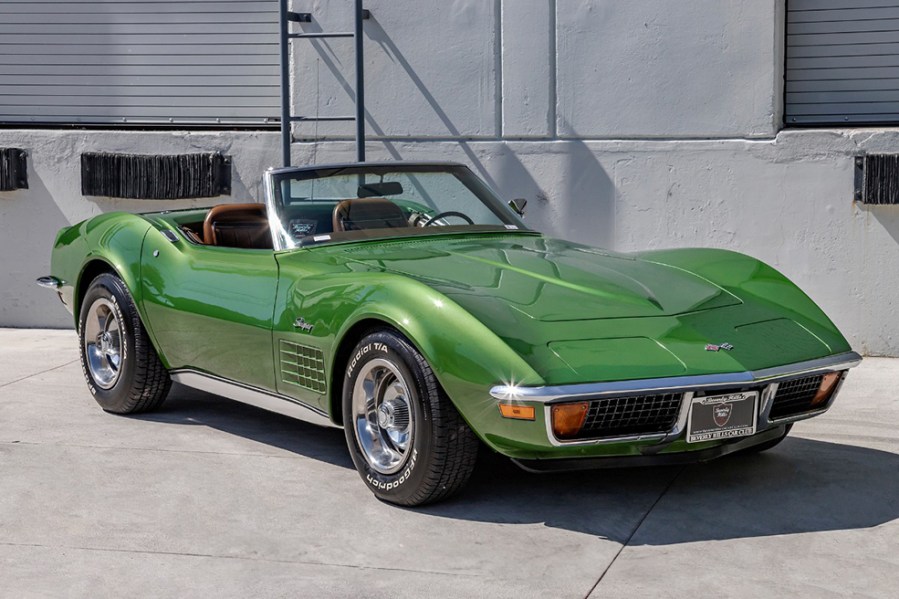The Chevrolet Corvette C3 is one of the most attainable and attractive examples of America’s sports car. Here’s how to buy a great one
Sponsored editorial in association with Beverly Hills Car Club
Words: Will Daniels Images: Beverly Hills Car Club
Built from 1968 up until 1982, the third-generation Chevrolet Corvette holds the record for the longest production run of any Corvette. The sleek sports car gained a loyal following over its impressive production run and was owned by celebrities, sports stars and even astronauts.
The Corvette C3 quickly became the star of films, television, music and motorsport, and was the first generation to serve as the official pace car of the Indianapolis 500. It wasn’t sold officially in the UK – luxury coupe fans had to make do with similar offerings from Mercedes, Jaguar and Jensen instead – but the C3 Corvette’s heritage is just as impressive and important as its European rivals’, and today there’s plenty of great examples on this side of the Atlantic.
The Corvette C3’s design was based on a concept penned by stylist Larry Shinoda called the Mako Shark II, one of many proposals for a mid-engined Corvette at that time. For the C3, however, the Mako Shark II’s lines were adapted to sit on traditional front-engine/rear-wheel drive underpinnings. The earlier cars retained the vertical rear screen and flying buttresses (together known as the ‘sugar-scoop’) of the mid-engine concept, which also gave rise to the targa-style roof.
The looks of the new Corvette were a closely guarded secret, but a few weeks before the unveiling Mattel launched its first Hot Wheels range and one of the 16 toy cars offered was a ‘Custom Corvette’ that had all the hallmarks of the C3. Hot Wheels designer Harry Bradley had spent four years working in GM’s design department and so was very familiar with the features of the Mako Shark II and when it was scheduled to be launched.
GM was initially extremely perturbed, but the instant success of the Hot Wheels toys only added to the hype surrounding the new Corvette and ensured that a generation of children wanted one as much as their parents did. Only in America could a toy car upstage the real deal at its launch!
As was the American way, from the start the Corvette came with a wide variety of options and specs. The C3 was initially offered as both a true convertible and the targa-top ‘coupe’ with removable roof panels. The sales split was initially almost even but quickly turned in favour of the coupe.
The very early pre-1970 cars’ engines were a choice of 327cu.in (5.3-litre) small-block V8 or the 427cu.in (7.0-litre) big-block, covering a range of power outputs from 300bhp for the basic 327 to 430bhp for the race-tuned big-block. The engines grew to 350cu.in (5.7-litre) and 454cu.in (7.4-litre) and up to more than 450bhp for the 1970 model year. Behind these was a selection of three- or four-speed manual gearboxes (with a choice of ratios) or the new three-speed Turbo Hydramatic auto.
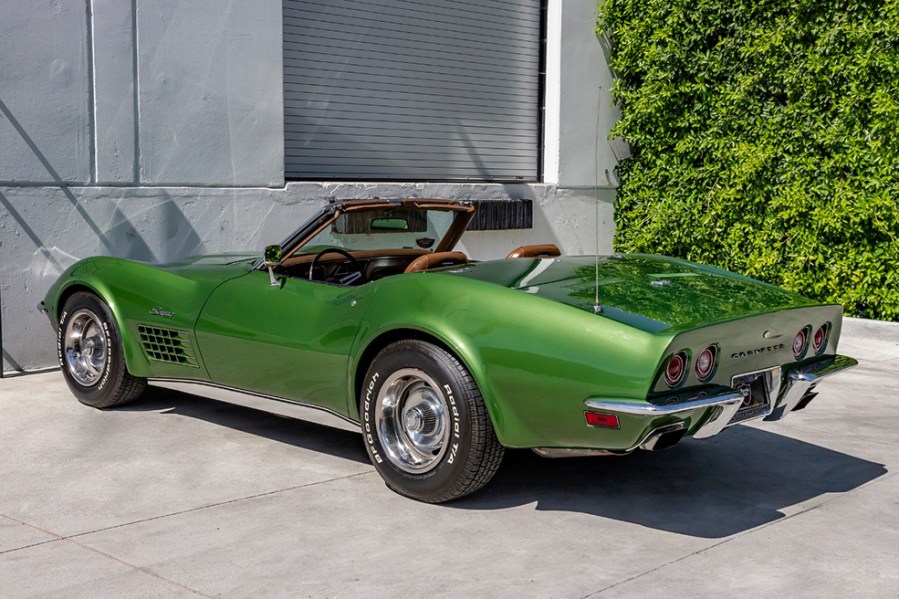
Mechanical options also included bigger brakes and the ‘Positraction’ limited-slip rear diff, while luxuries such as electric windows and power steering were also available. All are referred to by GM’s system of RPO (Regular Production Option) codes, which allow you to decipher the spec of any Corvette. ‘Holy Grails’ include the rare ZL1 all-aluminium 427 V8 (only offered in 1969), the J56 heavy-duty power-assisted brakes and, of course, the ZR1 and ZR2 high-performance models that put race-spec suspension, brakes and steering on tuned-up versions of the small- and big-block V8s respectively.
The 1973-77 cars suffered due to ever-toughening Federal emission rules, the fallout of the Energy Crisis, economic recession and shifting consumer demand. The big-block 454 V8 was dropped entirely after 1974, leaving the Corvette to be powered by variants of the 350 small-block. The convertible model was also dropped in 1975 and the C3 took a path away from being a pure sports car, becoming more of a luxurious GT with extra creature comforts including real leather seats, air conditioning, cruise control and an improved automatic transmission that would quickly see only about 10 per cent of Corvette buyers opting for a manual gearbox. It was a successful strategy, since more C3s were sold during this period than any other.
From 1976 the TH350 three-speed automatic replaced the old Turbo Hydramatic and all cars came with power brakes and power steering as standard. This was the best year for Corvette sales since 1968, with 46,558 sold. It was then beaten by an even better result for 1977, which saw total C3 production hit the half-million mark and annual sales of 49,213.
There were a few stylistic tweaks in 1977. Gone was the flying buttress design on the back end, replaced with a compound curve wraparound rear screen which effectively reintroduced the fastback style from the 1960s, proving that with a few tweaks a ten-year old design can still sell well. Another bumper period saw 100,000 sold between 1978 and ’79, with the Corvette hitting its 25th birthday. While 1979 saw the introduction of optional glass T-top sections, it also brought a power drop again due to yet more stringent emissions laws; 185bhp as standard (175bhp in California) and 220bhp on the L82, the most powerful variant – all from a 5.7-litre V8!
The final era of the C3 saw further stylistic tweaks and more use of plastics to lower the car’s weight, whilst front and rear spoilers became integral to the body, providing less drag and a more modern look. The engine choices in 1981 dropped to just one: the L81 350 V8 with GM’s Computer Command Control (which provided electronic control of the carburettor and ignition) and just 190bhp, with a speedo that read only up to 85mph. In the final years of the C3, ahead of the launch of its C4 successor, sales dropped by over 20 per cent.
The last year of C3 production saw the introduction of much of the technology that buyers would soon see in the C4. This included the fuel-injected Cross-Fire injection twin-throttle body 5.7-litre V8 that developed an improved 200bhp, mated to the updated Turbo Hydra-Matic 700R4 with an overdrive fourth gear. A special commemorative final edition of the 1982 cars were built, all with special trim and a unique plaque, which some collectors like to get excited about.
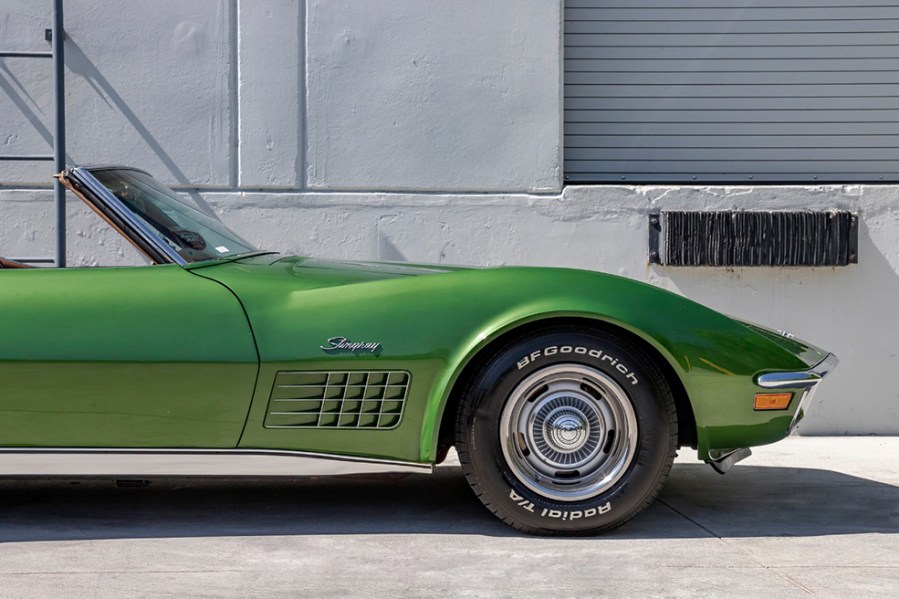
Bodywork
Yes, the car has a glassfibre body that doesn’t rust, but it can have its own set of ailments, particularly given the C3’s age. The chassis and other components can suffer the dreaded tin worm, so get the car on a ramp and take a look at the underside, paying particular attention to the chassis members, body mounts, the boxed rail sections behind the doors, rear trailing arms and their mounting points, and the radiator support and bumper support structures.
If you can, remove some trim panels to look at the inside of the door pillars, floors and the ‘birdcage’, which is the body structure that surrounds the cockpit and forms the sills, door pillars, screens and roof bridge assembly. Misaligned doors are a classic sign that something’s amiss in this area. If it’s a targa-top model, inspect the connecting steel section that links the front and rear and have a look at the condition of all the rubber seals. Good seals suggest a leak-free, dry car.
Pay close attention to panel gaps and the points where different glassfibre panels are bonded together – if it looks odd, find out why. It may point to previous poor repairs of accident damage. The same goes for the paintwork, which needs to be checked for ‘crazing’, suggesting either UV or stress damage, or more serious cracks that could be from an impact, poor previous repairs or a cheap repaint, possibly over repairs to the glassfibre. Check the operation of the headlights, since they are operated on a vacuum system using small rubber hoses that can deteriorate over time, resulting in loss of action.

Engine and transmission
The Chevy V8, in small- or big-block form, is famously unbreakable and even the most powerful versions found in the C3 don’t really approach what output these engines can handle, let alone the later ones with sub-200bhp. Make the usual checks for signs of worn bores (blue smoke, heavy crankcase pressure and probably some oil leaks), listen for rattles from seized piston rings or worn little ends, and check for tapping valve gear or rumbling bottom ends. Also check for low oil pressure (less than 20psi at a hot idle on the gauge). Any of these will point to poor maintenance or a car that’s done a lot of miles.
But these engines are simple to rebuild, and parts are in excellent supply – right down to a complete ‘turn-key’ crate engine that can be bought for £2000-3000. That pointed nose means the radiator is a little on the small side, especially for the more powerful big-block engines, so make sure the radiator core, the fan shroud and the hoses are all in good condition.
Like the engines, the automatic gearboxes are very durable and simple. Trouble is rare as long as the fluid has been changed at the proper intervals; but if the gearchange is ‘grabby’ or the drive slips in and out, then a rebuild is probably on the cards. This isn’t expensive and makes a good haggling point on an otherwise good car.
The rarer manual gearboxes tend to be a bit agricultural but, again, only show problems such as howling bearings or worn synchromesh if they’ve covered a lot of miles or have been subjected to a lot of hard driving, which is rare for a C3 these days.
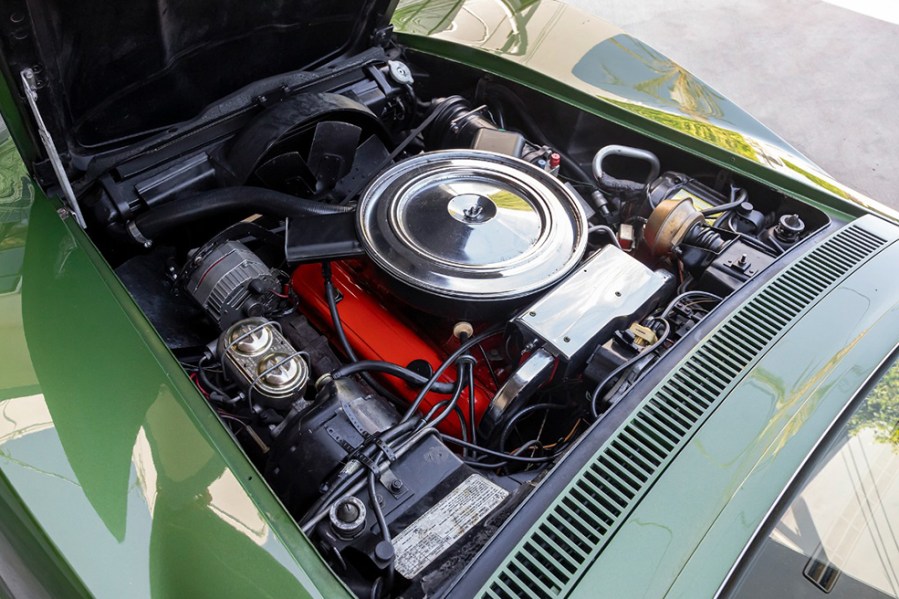
Suspension, steering and brakes
The C3 uses a similar set-up in terms of rear suspension to its C2 forerunner, this being independent rear suspension with a transverse leaf spring. Take the time to inspect U-joints, half-shafts and trailing arms for corrosion and obvious signs of age and damage, along with cracked or perished rubber bushes. Check the spring for cracked leaves and signs of sagging – the spring should be near-horizontal when taking the car’s unladen weight, with only a slight visible droop towards each end.
Make sure that components requiring lubrication (universal joints, half-shaft sliding joints, steering ball joints, tie rods and the trailing arms on some cars) have been properly maintained and greased, whilst also checking for leaks or other signs of deterioration.
American cars of the 1970s are not known for their precise steering and the Corvette is no exception – it won’t be razor-sharp but there should be little to no free play at the steering wheel, and a C3 should sit nicely on the road and drive straight and true. Sloppy steering indicates a steering box that’s worn or a ball joint issue, while wandering would point to wear in the front suspension. Check for leaks in the power steering system and look at the mounting brackets for the PAS pump, as these have been known to fracture as the cars age.
The all-disc braking system is generally reliable, although it is somewhat lacking in response in standard form and many C3s will have since been fitted with improved brakes. Do take time to check the condition of the brake callipers, discs, brake pipes and the reservoir for the colour of the fluid. Pay particular attention to the rubber bladder beneath the master cylinder cover to establish if it’s swollen or corroded, which suggests water contamination and poor maintenance. The pedal should be firm, not spongy, and the car should stop straight and true.

Interior and trim
Interior quality is not a Corvette strong point. Leather and vinyl materials crack and wear, and all suffer sun damage. The carpets can stain and fade, so check for this as well as water ingress marks. Trim can be fragile and door cards can wear or crack. Fortunately, everything is available from specialist Corvette suppliers in the USA at varying price points and quality levels, but all have a cost – not just the purchase price but duty and shipping need to be considered, as does the specific year of your chosen car because there were so many options and changes.
There are also some very good suppliers of parts in the UK who will keep many common items on the shelf, but some will require import straight from the States, so do your homework and shop around to compare prices.
Like many glassfibre-bodied cars, the C3 can be prone to electrical glitches, although these are nearly all down to poor earth connections or degraded wiring. Many C3s will have had some sort of rewiring by now, so check that it’s all good quality and that it’s neat, tidy and run through the right places. Switchgear can start breaking after 30 years or more and replacements are expensive but readily available from the States.
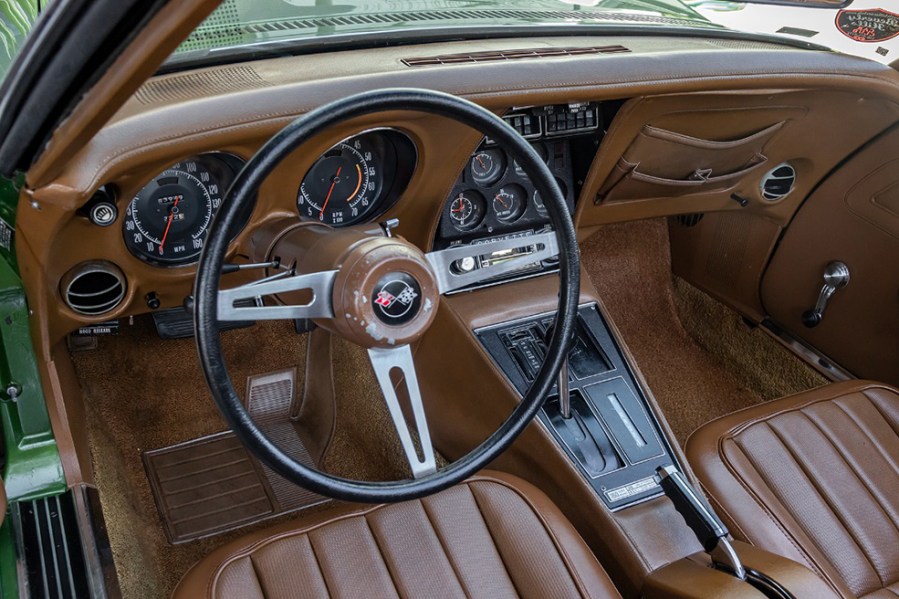
Chevrolet Corvette C3: our verdict
C3 values have really soared in recent years, so prepare to pay a decent sum for the right car – and more for a rarer, big-block variant or special edition. Buy well, however, and a Corvette should reward in both investment and enjoyment in that big-hearted, all-American way.
It’s still one of the more attainable Corvette models around but the C3 won’t stay affordable forever. Provided your wallet is braced for fuel-bill impact, now’s the time to buy.
It’s worth noting that many Corvette buyers like to check for a ‘numbers matching’ example, where the chassis, engine, transmission and rear axle serial numbers all match. True collectors really value this, while many owners take the view that upgrades and modifications are part of the spirit of the Corvette, and they therefore prefer a desirable spec over absolute originality. In any case, it’s helpful to know what a car’s original specification was, so you know what has been changed since.
The data tag on the driver’s door post will provide the VIN and the original paint/trim codes. There are some excellent websites that can help here, such as corvsport.com, which has a complete list of all the vehicle identification numbers, engine casting numbers and so on for each model year of Corvette produced. Also, the Corvette Black Book is akin to a bible for the serious collector, with 176 pages of build data and other information.
Sponsored by Beverly Hills Car Club
The automobiles sold at Beverly Hills Car Club combine all the elements of its exclusive address in Los Angeles: cars for sale that are the very last word in tasteful elegance, chic and impressive sophistication, with careful attention given to each vehicle and each client. Both national and international customers are catered for, including those in the UK, with a huge stock of classics to choose from.
The 1973 Corvette C3 in these pictures is one of many examples for sale at Beverly Hills Car Club at time of writing, priced at $39,950 and finished in its factory colour of Elkhart Green.
For more information and to view the Beverly Hills Car Club stock, visit beverlyhillscarclub.com
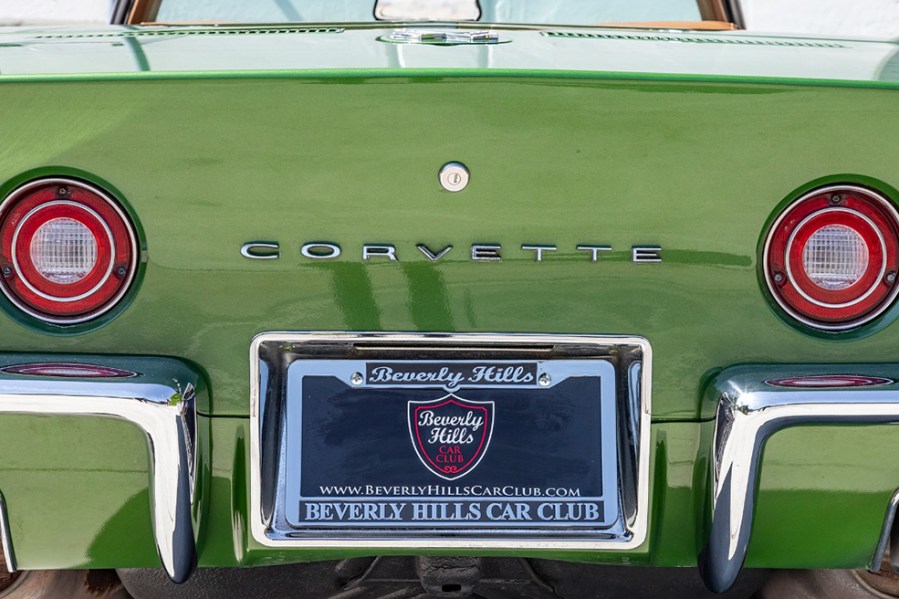
Chevrolet Corvette C3 timeline
1965
Mako Shark II concept car shown at the New York Auto Show as a preview of the next-generation Corvette’s design
1968
Corvette C3 arrives with swooping ‘coke-bottle’ styling, T-top coupe or convertible bodystyles and a chassis and engine lineup carried over from the previous Corvette C2
1969
Model-year changes include small block 5.4-litre V8 increased to 5.7 litres, standard steel wheels increased from seven to eight inches wide, optional white-lettered tyres and a smaller 15-inch steering wheel, among other detail updates
Three special-edition ‘Astrovettes’ leased to Apollo 12 astronauts
1970
Updates from January onwards include flared wheelarches, egg-crate grilles and side vents, rectangular exhaust tips and redesigned seats. Tinted windows, a wide-ratio manual gearbox and a Positraction rear axle were also made standard
LT1 5.7-litre small-block V8 added with 370hp, with an optional ZR1 package adding race-ready suspension, brakes and anti-roll bars
1971
All engines detuned to deal with lower octane fuel
7.4-litre LS6 big-block engine offered for 1971 only with 425hp, with ZR2 package offered
1972
Final chrome-bumper model year
1973
Polyurethane bumpers fitted along with radial tyres
L82 engine replaces LT1 unit
7.4-litre LS4 big block replaces LS5
1974
Rear end treatment revised to incorporate new bumper for a more modern look

1974 Chevrolet Corvette C3 with redesigned rear bumper
1975
Catalytic converter and electronic ignition added
Final year of C3 convertible production
1976
Steel floor panels added, cowl induction removed, new Vega GT steering wheel added, plus other detail changes
1977
Detail interior and exterior changes including redesigned centre console and removal of ‘Stingray’ lettering on the wings
Total Corvette production reaches 500,000 since 1953
1978
Fastback rear window added along with 25th anniversary badging on all 1978 cars
Various detail changes inside and out, including the addition of a glove box and metric tyres
Corvette runs as pace car at the 1987 Indy 500; 6,502 replica pace cars produced, one for each Chevrolet dealer
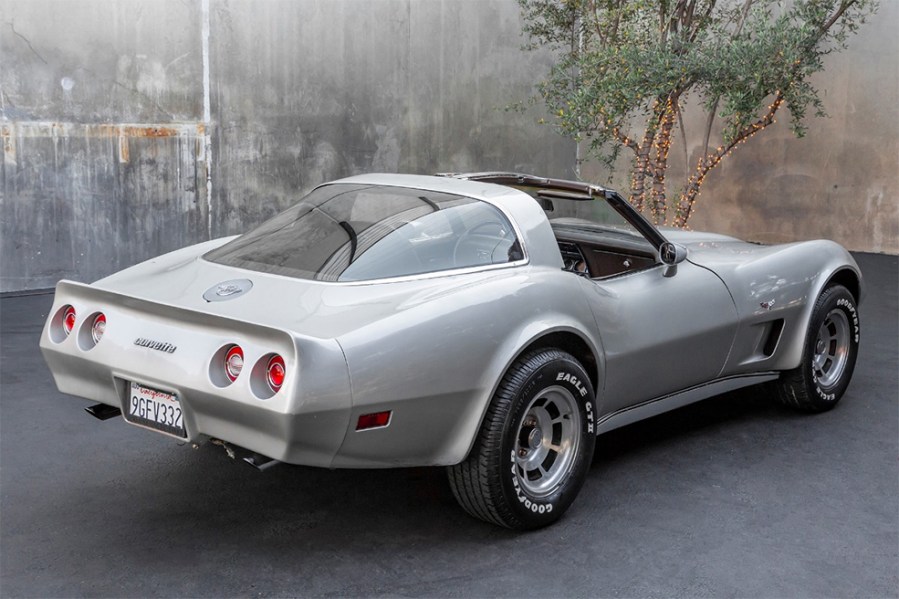
A fastback rear window was added to the Corvette C3 for its 1978 model year
1979
Bucket seats, a spoiler package and glass roof panels added, inspired by the previous year’s Indy 500 Pace Car replicas. Various detail changes inside and out
1980
Front and rear bumpers redesigned with aerodynamic spoilers
Air-conditioning now standard along with power windows, adjustable steering column and mandatory 85mph speedo
1981
5.7-litre L81 engine the sole powertrain option, available with manual or automatic gearbox
Fibreglass rear leaf-spring added to suspension setup for the first time
Corvette production moves from St Louis, Missouri to Bowling Green, Kentucky.
1982
Cross-Fire Injection throttle-body fuel injection system added along with new four-speed automatic gearbox
Collector Edition run-out special offered

